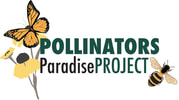 Planting native species to support nature and biodiversity is becoming more popular. This is great news for declining pollinator populations. At the same time, there are a number of myths and misconceptions around native plant gardening and pollinators that we are going to dispel in this blog post. Happy gardening for nature! Native plant gardens are weedy and unruly Truth: With thoughtful plant selection and design, and proper maintenance, native species gardens are gorgeous. As we do with all ornamental plants, gardeners select natives to serve particular design functions. Is it tall enough to go at the back of the border? Does it bloom when we want it to--either when nothing else is blooming, or when the bloom colour will coordinate with other plants blooming at the same time? Does it have a form or habit (upright, sprawling, arching) that works with the plants around it? It’s simply a matter of researching the plant habit, and understanding that, when placed in rich garden loam with lots of elbow room, many native plants will get bigger, and spread faster, than they would in a natural setting. Native plants can be enthusiastic re-seeders in a garden. You can minimize the deluge of seedlings every spring by deadheading (cutting off the spent flowers) during the growing season or, if the seed heads are eaten by birds, just leave them. Roguing out seedlings in the spring is a learning opportunity, an excellent way to get up close and personal with your garden while providing plenty of seedlings to give away. Many gardeners are also concerned with aggressive spreading through runners. It is true that SOME native species are aggressive spreaders but not all are! Canada Goldenrod is one aggressive species but do not judge all goldenrods by this one species behaviour! We have many species of goldenrods that are very mild mannered and will not spread by runners at all. Some well-behaved goldenrods include Stiff Goldenrod (Solidago rigida) for dry sun and Blue-stem (Solidago caesia) or Zig-zag Goldenrods (Solidago flexicaulis), for part shade). Goldenrods are bountiful contributors to biodiversity and are great pollinator plants. Although common milkweed (Asclepias syriaca) has a far-wandering root system, there are several species that work well in gardens. These “clumpers” include: Swamp Milkweed (Asclepias incarnata, good for loamy garden soil); Butterfly Milkweed (Asclepias tuberosa, good for drier spots); and Poke Milkweed (Asclepias exaltata, good for part shade.) There’s no harm in staking or supporting native plants if they get floppy or too tall. You can also cut them back to keep them shorter, although this may delay the bloom time by a week or so. And there’s no rule against mixing native and non-native in your garden--it’s not all or nothing! For choosing suitable native plants, visit the Ontario Native Plants website. Check out our Resources and Guides page.
10 Comments
|
Archives
December 2023
Categories |
|
|
Butterflyway Hamilton: www.facebook.com/butterflywayhamilton/
Environment Hamilton: https://www.environmenthamilton.org/ Hamilton Naturalists' Club: https://hamiltonnature.org/ |

 RSS Feed
RSS Feed